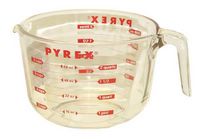Fame Of "PYREX" Mark Brings TTAB 2(d) Victory Over "PYR-O-REY"
Finding that PYREX is a famous mark for Section 2(d) purposes, the Board sustained an opposition to registration of the mark PYR-O-REY for "ovenware, namely glass casseroles and bakeware." Corning Inc. v. Vitrocrisa S.A. de C.V. Co., Opposition No. 91119107 (March 14, 2005)[not citable].

Much of the evidence offered by Opposer Corning Incorporated to prove the fame of the PYREX mark was submitted under seal as confidential, and therefore the Board did not provide the details. However, it found that:
"[t]he extraordinary amount of time that [the PYREX mark] has been used for cookware products, the amount of sales and the expenditures on advertising, the strong brand awareness, and household penetration, all to go demonstrate the fame of the mark."
The opinion does point out that the PYREX mark has been in use since 1915. In 1995, sales were $125M, with advertising expenditures of $3M. Sales in 1996 were in the $169M range (apparently the prior year's advertising effort paid off), when Corning spent "over $800,000 on television advertising." Corning's witness testified regarding survey results for 1994-95 indicating that 92% of those surveyed had heard of the brand.
The Board repeated its standard mantra that fame "plays a dominant role" in the Section 2(d) analysis. "As a mark's fame increases, the Act's tolerance for similarities in competing marks falls." Kenner Parker Toys, Inc. v. Rose Art Indus. Inc., 22 USPQ2d 1453, 1456 (Fed. Cir. 1992).
Turning to the most difficult issue, the similarity of the marks, the Board noted that, because the goods of the parties are in part identical, "the degree of similarity necessary to support a conclusion of likely confusion declines." The Board acknowledged the differences in appearance and pronunciation, but observed that "these differences fade in light of the fame of opposer's mark, the legally identical goods, and the fact that the goods may be purchased without care or deliberation."
Moreover, in a bit of a stretch, the Board noted that the connotations of the marks may be considered the same in some respects: "PYREX can be seen as being composed of the Greek word 'fire' and the Latin word 'king.' *** The literal translation of applicant's mark . . . is 'Fire of the King.'" [According to Applicant's testimony, the PYR-O-REY mark was chosen to indicate that its glassware is produced in Monterrey, Mexico].

The seldom-referenced DuPont factors regarding "market interface" and "any other established fact" played a role in the Board's Section 2(d) analysis. Vitrocrisa at one time had a business relationship with Corning and, despite being aware of Corning's view that confusion would be likely if the PYR-O-REY mark were used in the USA, proceeded to file the subject ITU application. "[t]his history reinforces that we should apply the well-established principle that doubt must be resolved in favor of opposer."
Corning also asserted a dilution claim, but the Board (as usual) elected not to consider it. Had the Board done so, the claim would likely have failed because the marks at issue are not "identical or 'very or substantially similar,'" as required for a finding of dilution. See the TTABlog post here.
In any case, why should an opposer undertake the expense and effort required to prove a dilution claim when the Board provides very broad rights to "famous" marks under Section 2(d)?
Text ©John L. Welch 2005. All Rights Reserved.




0 Comments:
Post a Comment
<< Home